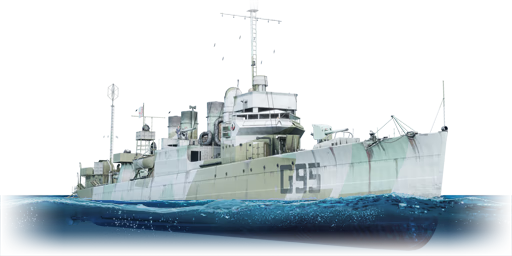



The HMS Montgomery is a premium British destroyer. It was introduced in Update "New Power".
HMS Montgomery, pennant number G95, part of the Town class is a destroyer provided to the Royal Navy by the United States Navy, during the early stages of the Second World War. Originally known as USS Wickes (DD-75), as the lead ship of the Wickes class.
Despite her resemblance with HMS Churchill, the Montgomery is moderately more self-sufficient in combat against other reserve destroyers, thanks to the preservation of 3 high-calibre guns. Though, unfortunately, this comes as a trade-off for the support armament of HMS Churchill. Other than these slight main armament changes, the Montgomery retains the same problematic aspects like modest crew count, low top speed and insufficient variety of secondary armaments. Therefore, players should decide whether this support/combat destroyer gameplay is more appealing than the escort role of the Churchill.
Unquestionably, Montgomery's premium status and decent combat characteristics ensure an effective way to research the early British Bluewater fleet, but if a player is more inclined to firepower than versatility, then consider purchasing HMS Verdun instead.
| Ammunition | Type | Armor penetration (mm) at a distance: | |||||
|---|---|---|---|---|---|---|---|
| 1000 m | 2500 m | 5000 m | 7500 m | 10000 m | 15000 m | ||
| HE | 11 | 11 | 11 | 11 | 11 | 11 | |
| SAP | 91 | 77 | 63 | 54 | 49 | 42 | |
| Shrapnel | 6 | 6 | 6 | 6 | 6 | 6 | |
| Ammunition | Type | Armor penetration (mm) at a distance: | |||||
|---|---|---|---|---|---|---|---|
| 100 m | 1000 m | 2000 m | 3000 m | 4000 m | 5000 m | ||
| HE | 8 | 8 | 8 | 8 | 8 | 8 | |
| Belt | Belt filling | Armor penetration (mm) at a distance: | |||||
|---|---|---|---|---|---|---|---|
| 10 m | 100 m | 500 m | 1000 m | 1500 m | 2000 m | ||
| API-T/AP/HEI/AP | 29 | 27 | 20 | 13 | 9 | 6 | |
48 × Mk.10 "Hedgehog" mortar
8 × Mk.6 mortar depth charge
48 × Mk.10 "Hedgehog" mortar






 2 x (90 / 125) %
2 x (90 / 125) % 
 2 x 100 %
2 x 100 % 

Seakeeping |
|---|
Unsinkability | |
|---|---|
Firepower | |
|---|---|